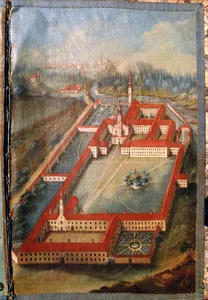
The history of Raitenhaslach monastery
The village of "Raitinhaselach" was first mentioned in a catalogue of goods produced by the Church of Salzburg in 788. In 1146, Cistercian monks from Salem on Lake Constance then founded the daughter monastery Raitenhaslach on the high banks flanking the river Salzach. An initial attempt to establish a monastery failed in Schützing an der Alz due to the unfavorable ground and regular floods. Raitenhaslach received the King's protection as early as 1149.
The Cistercian monks gave the majority of the endowed land to free farmers, who had to pay interest, as well as to serfs. The monks mostly recruited from families of craftsmen or tradesmen. Over the course of time, the Raitenhaslach Cistercian monks adopted a wide range of economic activities, ranging from forestry, hunting, fishing, milling, paper production, smithery, salt mining and dairy farming to winemaking and brewing.
Catastrophic fires were no rare occurrence in the Middle Ages, and the monastery buildings in Raitenhaslach burnt down twice – in 1267 and 1485. Nevertheless, the abbey was one of the richest monasteries in Old Bavaria in the 13th and 14th century, with estates stretching well into Upper and Lower Austria and houses in 14 towns.
In contrast to this, the 16th century marked the darkest period in the monastery's history, as it built up huge debts on the back of poor management and high taxes. Many of its estates had to be sold. Only the abbot and two conventual staff still lived here in 1573.
Commencing in 1690, the Baroque additions to the Romanesque church ushered in construction activities that intensified under the Abbot Emanuel II Mayr (1759 – 1780), who was a prolific builder, before being completed in 1785 with the opening of the much admired library. The construction work on the prelate's wing was completed in 1762, a mere ten years after its cornerstone was laid. In 1764, the painter Johann Martin Heigl put the finishing touches on the ceiling fresco in the ceremonial hall. When a landslide destroyed the monastery building in the south-east of the site in 1766, the new prelate's wing remained unscathed. A guest room was set up in the prelate's wing for Pope Pius VI in 1782, as the Holy Father was travelling back from Vienna. However, there is no evidence that the Pope actually slept at the monastery.
On January 25, 1802, Elector Max IV Joseph ordered the closure of almost all monasteries in the Electorate of Bavaria. This move was not only aimed at the appropriation of the monasteries' property, but also the centralization of jurisdiction, social care and school education to the state. Franz Graf von Armansperg, state judge for Burghausen, was installed as local commissioner for Raitenhaslach monastery. He secured and seized the monastery's assets.
In 1803, the last "white monks" were dismissed and granted modest pensions. Ausanias Detterle, the last abbot of the monastery, acquired the Abteistöckl building and lived there until his death in 1829. The library and around half of the baroque buildings were torn down, and the monastery church was converted into a parish church. With the auctioning off of the remaining "movable assets and property", a monastery tradition stretching back over 650 years ended in 1803.
The majority of the monastery site then came into the private ownership of the Baumgartner brewer family from 1804 to 2003. In 2003, the City of Burghausen acquired the majority of the site, while an entrepreneur purchased the traditional monastery inn in 2004. In the same year, preliminary investigations into restoring the prelate's wing began.
In the period up to 2011, several TUM chairs researched the structural condition of the building. Finally, the City of Burghausen signed an agreement with the Technical University of Munich in 2013 which allows the university to use the prelate's wing as a conference center for 25 years. The official opening ceremony of the TUM Science & Study Center Raitenhaslach took place on June 4, 2016.
